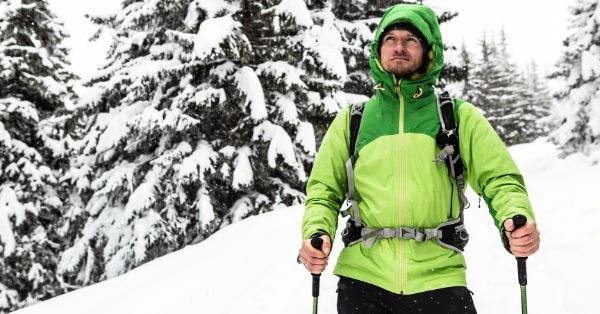It is important to know how to stay warm hiking in winter. When the snow-covered mountains call, many outdoor enthusiasts embrace the opportunity to go hiking in winter. However, staying warm and comfortable in frigid temperatures can only be challenging with the right knowledge and gear.
In this article, we will come up with essential tips, gear recommendations, and advice on how to stay warm while hiking in winter. And discuss the best practices to ensure a safe and enjoyable winter hiking experience.
Stay Warm and Dry
To stay warm during winter hikes, keeping your clothing dry is crucial. Moisture can quickly rob your body of heat, so take the following precautions:
- Avoid Cotton: Cotton retains moisture and dries slowly, making it a poor choice for winter hiking. Instead, opt for moisture-wicking and quick-drying materials like merino wool or synthetic fabrics.
- Carry Extra Clothes: Pack an extra dry cloth set in a waterproof bag to change if your clothing gets wet.
Dress in Layers
Layering plays a crucial role in ensuring warmth during snowy conditions. The layering technique involves wearing multiple layers of clothing to trap heat and provide insulation. Start with a moisture-wicking base layer. That will keep you dry by wicking away sweat from your body. Over the base layer, wear an insulating mid-layer such as a fleece or down jacket. Lastly, complete your attire by adding a waterproof and windproof outer layer to shield you against various weather conditions.
Choosing the best hiking jacket for cold weather is crucial. Look for jackets that provide insulation, breathability, and water resistance. Down jackets are excellent for extreme cold as they offer an exceptional warmth-to-weight ratio. Synthetic insulated jackets are also a good option as they provide insulation even when wet.
Have you ever wondered why some hikers wear space blankets? An experienced hiker, Chuck wears a space blanket as an additional layer of protection. Space blankets are made of thin, heat-reflective material that helps retain body heat. They are lightweight, compact, and can be a lifesaver in emergencies.
Invest in Quality Winter Hiking Gear

Choosing the right gear is paramount to staying warm during winter hikes. Consider these essentials:
- Hiking Jacket: Look for a high-quality winter hiking jacket that provides insulation, wind and water resistance. The best hiking jackets for cold weather are often made with advanced materials that offer warmth without sacrificing breathability.
- Winter Hiking Boots: Opt for insulated and waterproof hiking boots with good traction to keep your feet warm and dry. Seek out boots with thick soles that provide insulation against the cold ground.
- Winter Hiking Pants: Choose water-resistant, windproof, and insulated pants to save your legs from the cold. Look for options with reinforced knees and seats for added durability.
- Winter Hiking Shoes: Use hiking shoes instead of boots for less extreme winter conditions. These shoes are lighter and more flexible while still providing insulation and waterproofing.
Bonus:
How To Attach Hiking Poles To Backpack?
Protect Your Extremities
Protecting your extremities is significant when hiking in the cold, as they are more prone to frostbite. Consider the following gear options:
- Balaclava: Invest in a good balaclava or face mask to protect your face, neck, and head from biting winds and freezing temperatures. Look for one that covers your nose and mouth for added warmth.
- Gloves: Opt for insulated and waterproof gloves that provide excellent dexterity, grip, and warmth. Look for gloves specifically designed for hiking in cold weather.
Tips And Techniques For Staying Warm
You can employ several tips and techniques to stay warm while hiking in winter.
- Maintaining a solid base layer is one of the most critical factors. Choose a base layer of moisture-wicking material that will keep you dry by pulling sweat away from your skin.
- Insulating with mid-layer clothing is another key strategy. Fleece jackets, wool sweaters, or down vests are excellent options for providing extra insulation. These layers trap heat close to your body and prevent it from escaping, keeping you warm even in freezing temperatures.
- Remember to protect your extremities. Significant heat loss occurs through the head, so wearing a warm hat or beanie is crucial. Cover your ears and neck as well to prevent heat loss. Invest in high-quality insulated gloves.
- When it comes to your feet, choose appropriate socks and footwear. Opt for moisture-wicking socks crafted from Merino wool or synthetic fibers to ensure dryness and warmth for your feet. Waterproof and insulated hiking boots or winter shoes with good traction are vital for hiking in snowy and icy conditions. Additionally, gaiters can help keep snow from entering your boots and dry your lower legs.
- Consider using heat-reflective materials and techniques to maximize warmth. Certain clothing items are designed with heat-reflective materials that help retain body heat. Look for jackets, pants, and blankets with these features for added warmth. You can also line your sleeping bag or tent with emergency blankets.
- Staying active is one of the most efficient ways to generate body heat. Keep moving while hiking, as physical activity helps increase blood flow and generates warmth. Take breaks when necessary but avoid staying idle for too long, as this can lead to a drop in body temperature. For more ideas, visit my Pinterest.
Hiking In 20 Degree Weather
Hiking in 20-degree weather requires special considerations. Dress in layers, ensuring enough insulation to keep warm without overheating. Wear moisture-wicking socks and invest in waterproof boots to keep your feet dry. Use gaiters to remove snow from your boots and carry hand warmers or feet.
Conclusion
Staying warm while hiking in winter is essential for a safe and enjoyable outdoor adventure by following these tips and techniques mentioned in this article. Such as proper layering, choosing the right gear, and employing heat-reflective materials, you can ensure that your tenure is warm and comfortable even in the coldest conditions. Remember to dress in layers, protect your extremities, and stay active to generate body heat. With the right preparation and gear, you can embrace the beauty of winter landscapes while keeping warm and safe.
FAQs
Q.1 What are the best winter hiking outfits for ladies?
Ans: The best winter hiking outfits for ladies include insulated pants, moisture-wicking base layers, a warm jacket, sturdy boots, and gloves.
Q.2 How do I stay warm while hiking in deep snow?
Ans: To stay warm in deep snow, dress in layers, wear insulated waterproof boots, use gaiters to keep snow out of your boots and consider using snowshoes for better traction and insulation.
Q.3 What are the best gloves for hiking in cold weather?
Ans: Some of the best gloves for hiking in cold weather include the Black Diamond Mercury Mitts, Outdoor Research Alti Gloves, and The North Face Etip Gloves. These gloves offer insulation, water resistance, and excellent grip for outdoor activities.
Q.4 Can I hike alone in winter?
Ans: Hiking alone in winter can be risky due to the harsh conditions and potential hazards. It is generally recommended to hike with a partner or in a group for added safety. If you choose to hike alone, inform someone of your plans and carry essential safety equipment.
Q.5 How do I prevent my water from freezing during winter hikes?
Ans: Consider using insulated water bottles or hydration reservoirs to prevent your water from freezing during winter hikes. Insulating your water containers with insulating sleeves or placing them inside an insulated pack can also help prevent freezing.
Bonus:

